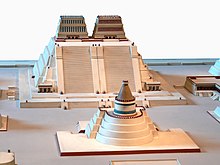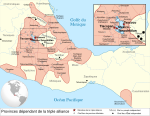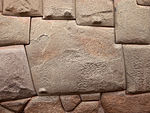Aztec architecture


Aztec architecture is a late form of Mesoamerican architecture developed by the Aztec civilization. Much of what is known about it comes from the structures that are still standing. These structures have survived for several centuries because of the strong materials used and the skill of the builders.[1]
Influences[]
Aztec architecture reflects the migration of the Aztec civilization across present-day Mexico.[2] The style of early Aztec pyramids was adapted from those of Classic and other Postclassic Mesoamerican people.[2] Aztec architecture subsequently influenced later Mesoamerican styles.[3]
The ancient Aztecs relied on cosmology, astronomy, and religion as their main sources of inspiration. Aztec religious beliefs are reflected in the designs of the religious structures as well as domestic structures.[2]
History[]
The most significant architecture of the Aztec Empire was located in the capital city Tenochtitlan, which was destroyed after the Spanish conquest in the 16th century.[2] Materials taken from the city were used in the construction of Mexico City.[2] There is not much remaining archaeological evidence at Aztec sites like the Aztec Temple Square.[4]
Aztec architectural sites include Malinalco, Tenayuca, conquered by the Aztec circa 1434; the earliest known example of the typical Aztec double pyramid, which consists of joined pyramidal bases supporting two temples; and the Templo Mayor, the biggest building in the Aztec city Tenochtitlan.
Aztec cities often competed to construct the greatest temples in the Aztec empire.[citation needed]
Style[]
Aztec architecture is characterized by symmetry and elements like geometric designs and sweeping lines.[2]
There are also many symbolic elements, including the four cardinal directions, which each represents a deity, color, and symbol.[2] Animal symbols also served as representations: eagles represent the sun and warriors, serpents represented water or fire, and conch shells were fertility symbols.[5] The temples themselves represented mountains, Aztec symbols for water and fertility.[2] The architecture, particularly the sculptures on and in the temples, were symbolically painted.[6]
Types of structures[]
The structures in the city of Tenochtitlan included temples, palaces, and platforms.[7] The temples were terraced pyramids with steep stairs leading up to the main temple. Domestic structures reflected the social and financial status of inhabitants.[8] Elites lived in palaces, which were called tecpans.[9] Houses were uniform throughout most of the empire, only varying in size and ornamentation.
The Aztecs built causeways and chinampas in Tenochtitlan due to its location in the Mexico City basin.[7]
Building techniques[]
The Aztecs had advanced knowledge of building techniques, and they knew how to build on the local geology and terrain, particularly the soft soil. The builders employed stone bases for the temples. J. A. Joyce writes that "[t]he physical geography of Central America was favorable to the rise of the art of building in stone."[10]
Aztecs also used gravity to make a running water system, bringing fresh water to the city grid and employed terracing to enhance agricultural productivity.[11]
Instead of demolishing old temples and building a new one at the same site, the Aztecs simply built over the existing structures, which resulted in larger and more detailed pyramids.[2] Some temples have been found to have at least four or five layers.
Relationship with Aztec culture[]
The Aztecs designed their buildings to be functional for everyday life as well as religious practices. The architectural style of the Aztecs reflected relationships with a higher power. In Tenochtitlan, the layout of the city represented the birth of Huitzilopochtli.[12]
The teocalli, or pyramid-temples, were significant to Aztec religious practices. They were the sites of religious celebrations and rituals.[2] The temples represented ascension. There were multiple torn levels, which each correlated with different classes. The Aztecs believed that ascension was the processing of preparing oneself to please the gods. At the top was the main temple where sacrifices took place, since that was considered to be closest to the gods.
The households were simpler yet uniform to the rest of the civilization. The Aztecs did not want a mismatched civilization. This could displease the gods in the eyes of the Aztecs.[citation needed] Houses could be one to two stories tall.[10]
Separation of classes[]
Aztec culture had class stratification. The highest social rank was that of the priesthood, which permitted access to the temples and more exclusive quarters. Members of the priesthood lived near the temples while people of lower classes lived increasingly further away according to their status. The sizes of domestic structures reflected differences in wealth, power, and status.[13]
References[]
- ^ Correspondence in Hobart, Okla N. "AZTEC ARCHITECTURE." The Construction News (1897-1916), vol. 21, no. 12, 1906, pp. 220, American Periodicals
- ^ Jump up to: a b c d e f g h i j Aguilar-Moreno, Manuel (2007). Handbook to Life in the Aztec World. Oxford University Press. ISBN 978-0-19-533083-0.
- ^ Rice, Don Stephen (1993). Latin American Horizons: A Symposium at Dumbarton Oaks, 11th and 12th October 1986. Dumbarton Oaks. ISBN 978-0-88402-207-7.
- ^ Association for Computer-Aided Design in Architecture. Conference (2001). Reinventing the discourse : how digital tools help bridge and transform research, education and practice in architecture : proceedings of the twenty first annual conference of the Association for Computer-Aided Design in Architecture, October 11-14, 2001, Buffalo, New York. Wassim Jabi, Association for Computer-Aided Design in Architecture. [Place of publication not identified]: Association for Computer-Aided Design in Architecture. ISBN 1-880250-10-1. OCLC 48456547.
- ^ "Aztec Architecture". Legends & Chronicles. Retrieved 2019-09-24.
- ^ Boone, Elizabeth Hill (1985). Painted Architecture and Polychrome Monumental Sculpture in Mesoamerica: A Symposium at Dumbarton Oaks, 10th to 11th October, 1981. Dumbarton Oaks. ISBN 978-0-88402-142-1.
- ^ Jump up to: a b Herzog, Lawrence A. (2001). From Aztec to High Tech: Architecture and Landscape Across the Mexico-United States Border. JHU Press. ISBN 978-0-8018-6643-2.
- ^ Olson, Jan Marie; Smith, Michael E. (2016). "MATERIAL EXPRESSIONS OF WEALTH AND SOCIAL CLASS AT AZTEC-PERIOD SITES IN MORELOS, MEXICO". Ancient Mesoamerica. 27 (1): 133–147. doi:10.1017/S0956536115000334. ISSN 0956-5361.
- ^ Palaces of the ancient new world : a symposium at Dumbarton Oaks, 10th and 11th October 1998. Susan Toby Evans, Joanne Pillsbury, Dumbarton Oaks. Washington, D.C.: Dumbarton Oaks Research Library and Collection. 2004. ISBN 0-88402-300-1. OCLC 57392889.CS1 maint: others (link)
- ^ Jump up to: a b Joyce, J. A. (1911). "Some Features of Mexican Architecture". The Burlington Magazine for Connoisseurs. 19 (99): 154–163. ISSN 0951-0788.
- ^ Arco, Lee J.; Abrams, Elliot M. (Dec 2006). "An essay on energetics: the construction of the Aztec chinampa system". Antiquity. 80 (310): 906–918. ISSN 1745-1744.
- ^ Rivera, García Ocampo (2016). Towards an understanding of Aztec architecture and urban planning (Thesis). University of British Columbia.
- ^ Smith, Michael E.; Heath-Smith, Cynthia; Montiel, Lisa (1999). "Excavations of Aztec Urban Houses at Yautepec, Mexico". Latin American Antiquity. 10 (2): 133–150. doi:10.2307/972199. ISSN 1045-6635.
Further reading[]
- Bernal, I; Coe, M; et al. (1973). The Iconography of Middle American sculpture. New York: The Metropolitan Museum of Art.
External links[]
| Wikimedia Commons has media related to Aztec architecture. |
- Architectural styles
- Aztec
- Mesoamerican architecture

